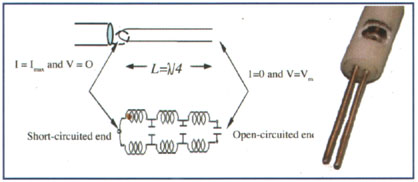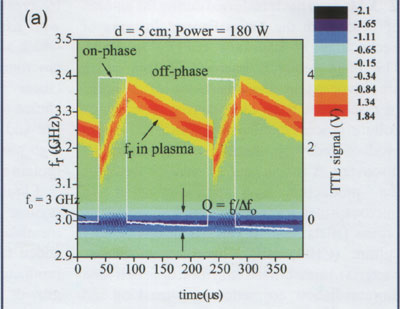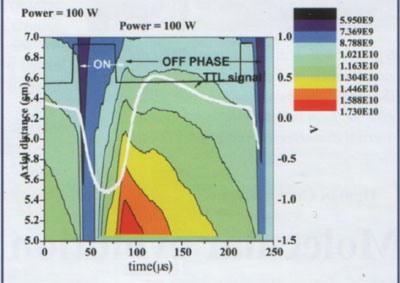| 2006 |

|
YEAR BOOK |
Dublin City University
|
A floating hairpin resonance probe for measuring spatially resolved absolute electron density in
a discharge
|

The conventional Langmuir probe used for measuring plasma properties draws currents from the plasma causing perturbation to the discharge; there are other problems associated with Langmuir probes. In depositing plasma, the probe gets coated by insulating films, resulting in inaccurate measurements. In some plasma tools, there are no grounded reference electrodes present to return the probe current back to the plasma, therefore measuring the probe's V-I characteristics is often difficult. In magnetized discharges such as magnetron sputter deposition and in fusion-plasma applications, the electrons are highly magnetized; the Langmuir probe under�estimates the electron density. Beyond these specific problems, there is no way to perform an absolute calibration of a Langmuir probe, and even in ideal systems and with great care the measured number density can be in error by 30% or more [1] . In pulsed radio-frequency (rf), high-pressure arcs, etching and deposition, atmospheric pressure discharges, etc; the Langmuir probe techniques, are found to be highly problematic.
Stenzel [2] in 1976 invented a diagnostic technique for measuring absolute electron density in the discharge using a microwave resonance probe. The principle of the probe is simple and is based on measuring the dielectric constant of the plasma surrounding the resonant structure. The probe consists of two parallel wires that are short circuited at one end and open at the other and resembles a hairpin (Fig 1). The typical length of the hairpin is 1-2 cm. The hairpin resonates at a particular frequency fr for which the quarter wavelength of the microwave frequency equals to the length of the hairpin. After nearly a gap of 30 years, Piejak [1] developed a compact version of the probe by simplifying detection of the probes resonance frequency using microwave reflections measurement technique. We have further improved this technique by incorporating the features of a floating microwave resonance probe [2] and the resonance peak measurement technique is similar to Piejak [1] , to make a "Floating-hairpin resonance probe" [4] . This allows minimal perturbation to the discharge. So far this technique has been used in the public domain for measuring electron density and also for measuring negative ion densities in conjunction with laser photo-detachment [3] . In metal deposition systems, high-pressure pulsed discharge where the sheaths are highly collisional; and for measuring time-resolved density in pulsed rf where the plasma potential is rapidly varying, resulting in time-varying sheaths around the probe. Finally it is used for for measuring phase-resolved density in dual radio-frequency capacitive confined industrial plasma tool.
An example of the application of the technique for measuring time-and space resolve electron density in a pulsed radio-frequency magnetron sputter reactor, is illustrated in figures 2 and 3.


� High absolute accuracy for measuring electron density (within < 3% errors),
� Very high reproducibility (within <1% error),
� Allows real-time monitoring of the electron density variation in the discharge (bandwidth of 10 mHz through 30MHz);A fundamental feature of the technique is that the vacuum measurement provides an absolute calibration of the system. Unlike Langmuir probes, the repeatability is maintained independent of the physical condition of the probe-tip that may vary between processes. Further research on developing a commercial proto-type hairpin probe set up is currently under progress.
Acknowledgement:
This material is based upon works supported by the European Union funding under EURATOM Fusion contract FU06-CT-2004-00068.
References:
[1] R.B.Piejak, V.A.Godyak, R.Garner, B.M. Alexandrovich, N. Sternberg, Journ. Appl. Phys. 95(7) 3785 (2004)
[2] R.L.Stenzel, Rev. Sci. Instrum. 47(5) 603 (1976)
[3] G.A.Hebner and I. C. Abraham, Journal of Applied Physics, 90(10), 4929 (2001)
[4] S.K.Karari and A.R.Elingboe, Appl.Phys.Lett. 88,101501 (200^)
Contact : Dr. Shantanu Karkari, National Centre for Plasma Science and Technology, Dublin City University,
Glasnevin, Dublin 9. Tel: 01-7007787,
E-mail: [email protected]
Web: www.ncpst.ie